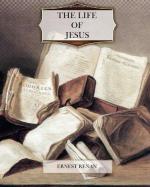[Footnote 1: Mark ix. 10.]
[Footnote 2: Matt. xi. 14, xvii. 10-13; Mark vi. 15, ix. 10-12; Luke ix. 8; John i. 21-25.]
[Footnote 3: Luke i. 17.]
[Footnote 4: Matt. xxi. 32; Luke vii. 29, 30.]
The disciples of Jesus were faithful to these principles of their master. This respect for John continued during the whole of the first Christian generation.[1] He was supposed to be a relative of Jesus.[2] In order to establish the mission of the latter upon testimony admitted by all, it was declared that John, at the first sight of Jesus, proclaimed him the Messiah; that he recognized himself his inferior, unworthy to unloose the latchets of his shoes; that he refused at first to baptize him, and maintained that it was he who ought to be baptized by Jesus.[3] These were exaggerations, which are sufficiently refuted by the doubtful form of John’s last message.[4] But, in a more general sense, John remains in the Christian legend that which he was in reality—the austere forerunner, the gloomy preacher of repentance before the joy on the arrival of the bridegroom, the prophet who announces the kingdom of God and dies before beholding it. This giant in the early history of Christianity, this eater of locusts and wild honey, this rough redresser of wrongs, was the bitter which prepared the lip for the sweetness of the kingdom of God. His beheading by Herodias inaugurated the era of Christian martyrs; he was the first witness for the new faith. The worldly, who recognized in him their true enemy, could not permit him to live; his mutilated corpse, extended on the threshold of Christianity, traced the bloody path in which so many others were to follow.
[Footnote 1: Acts xix. 4.]
[Footnote 2: Luke i.]
[Footnote 3: Matt. iii. 14, and following; Luke iii. 16; John i. 15, and following, v. 32, 33.]
[Footnote 4: Matt. xi. 2, and following; Luke vii. 18, and following.]
The school of John did not die with its founder. It lived some time distinct from that of Jesus, and at first a good understanding existed between the two. Many years after the death of the two masters, people were baptized with the baptism of John. Certain persons belonged to the two schools at the same time—for example, the celebrated Apollos, the rival of St. Paul (toward the year 50), and a large number of the Christians of Ephesus.[1] Josephus placed himself (year 53) in the school of an ascetic named Banou,[2] who presents the greatest resemblance to John the Baptist, and who was perhaps of his school. This Banou[3] lived in the desert, clothed with the leaves of trees; he supported himself only on wild plants and fruits, and baptized himself frequently, both day and night, in cold water, in order to purify himself. James, he who was called the “brother of the Lord” (there is here perhaps some confusion of homonyms), practised a similar asceticism.[4] Afterward,




